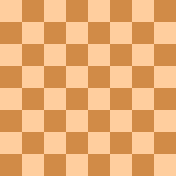Zugzwang facts for kids
Zugzwang (pronounced TSOOG-tsvahng) is a special word used in chess. It describes a situation where a player has to make a move, but every possible move they can make will actually make their position worse. It's like being forced to do something that hurts your own game!
Imagine you're playing chess and it's your turn. If you're in zugzwang, no matter what piece you move, your opponent will gain a big advantage. You are "compelled to move," meaning you have no choice but to make a move that weakens your position.
Contents
How Zugzwang Works
Let's look at an example to understand zugzwang better.
| a | b | c | d | e | f | g | h | ||
| 8 |

|
8 | |||||||
| 7 | 7 | ||||||||
| 6 | 6 | ||||||||
| 5 | 5 | ||||||||
| 4 | 4 | ||||||||
| 3 | 3 | ||||||||
| 2 | 2 | ||||||||
| 1 | 1 | ||||||||
| a | b | c | d | e | f | g | h | ||
If Black Has to Move
If it is Black's turn to move in the position shown above, White cannot win the game. Here's why:
1. ... Kd7 Black moves their king to d7.
2. c6+ Kc7 White's pawn moves forward, checking Black's king. Black moves their king to c7.
3. Kc5 Kc8 White's king moves to c5, and Black's king moves to c8.
4. Kd6 Kd8 White's king moves to d6. Black's king moves to d8, blocking White's king.
5. c7+ Kc8 White's pawn moves to c7, checking Black's king again. Black's king moves to c8.
6. Kc6 White's king moves to c6. Now, Black has no legal moves, but their king is not in check. This is called a stalemate, and the game is a draw.
If White Has to Move
Now, let's imagine it's White's turn to move in the very first position. White can win the game because Black will be in zugzwang.
1. Kc6! White moves their king to c6. This is a very strong move!
Now, Black must move their king. No matter where Black's king moves, White will be able to push their pawn forward and turn it into a queen. For example:
1..... Kd8 Black moves their king to d8.
2. Kb7 White moves their king to b7. Now, White's pawn can easily advance to the last rank and become a queen, winning the game. Black was forced to make a move that led to their loss.
Mutual Zugzwang
| a | b | c | d | e | f | g | h | ||
| 8 |

|
8 | |||||||
| 7 | 7 | ||||||||
| 6 | 6 | ||||||||
| 5 | 5 | ||||||||
| 4 | 4 | ||||||||
| 3 | 3 | ||||||||
| 2 | 2 | ||||||||
| 1 | 1 | ||||||||
| a | b | c | d | e | f | g | h | ||
Sometimes, a chess position can be so tricky that it's a "mutual zugzwang." This means that no matter whose turn it is, the player who has to move will end up in a worse position and lose the game.
In the diagram above, if it's White's turn, White will lose their pawn. If it's Black's turn, Black will lose their pawn. In either case, the player who moves will lose the game because their opponent will then be able to win.
History of the Term
The idea of zugzwang has been around for a very long time, even in older versions of chess like shatranj. Ancient Arabic chess problems show that players understood this concept.
The actual word "zugzwang" comes from a German chess magazine in the 19th century. It's a German word that means "compulsion to move." It started being used in English chess books and articles in the early 20th century.
See also
 In Spanish: Zugzwang para niños
In Spanish: Zugzwang para niños

